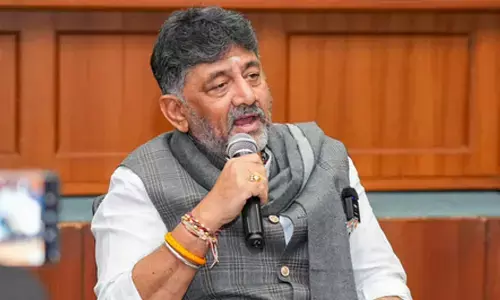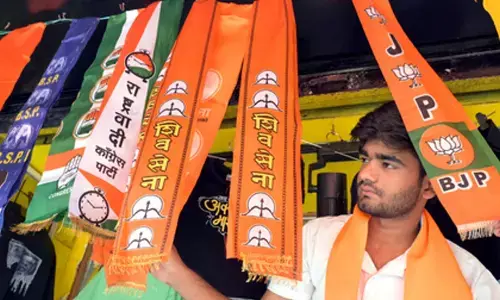Characterising September 17

The Bharatiya Janata Party (BJP) has found in the run-up to the low-key September 17 celebrations a golden chance to corner the Telangana Rashtra Samithi (TRS) government. The State government’s disinclination to officially celebrate the day, let alone hype, has given ammunition to the saffron brigade.
The Bharatiya Janata Party (BJP) has found in the run-up to the low-key September 17 celebrations a golden chance to corner the Telangana Rashtra Samithi (TRS) government. The State government’s disinclination to officially celebrate the day, let alone hype, has given ammunition to the saffron brigade.
The primary allegation of BJP is that the Muslim appeasement policy of TRS underpins the State government’s unwillingness to observe the day officially. Noticeably, the BJP's own characterisation of September 17 also flows from a religious standpoint: that of projecting it as the day of dislodgement of a Muslim ruler. In effect, both these readings are erroneous and spring from distorted views of history.
Characterising the struggle of Telangana peasantry against feudal exploitation patronised by the Nizam autocracy as a religious conflict is not only unbecoming of the BJP, but also reflective of the party’s misinterpretation of history. At the end of the day, it would also tantamount to rendering a grave injustice to the martyrs of Telangana people’s armed struggle.
Notwithstanding its political content, it was in toto a valiant struggle for ushering in an egalitarian social order. It was founded on the indefatigable efforts of the courageous legions who revolted against all forms of feudal exploitation. It was, therefore, an epoch-making struggle against odds to emancipate people from monarchy, which had been perpetuating an exploitative, archaic social order.
Writing about this unique struggle in his book, India's Struggle For Independence, noted historian Bipan Chandra said: “The movement had succeeded in instilling into the oppressed and downtrodden peasants of Telangana a new confidence in their ability to resist.” (Page 395).
There are three varying schools of thought in characterising the September 17 and its historical significance. First, as this was the day on which the erstwhile Hyderabad state was integrated into the Indian Union, it is ‘Integration Day.’
The BJP feels that it was the day on which the then Home Minister Sardar Patel liberated the people of this region from the clutches of Muslim king, and hence the day is ‘Liberation Day.’ There is also a section that believes that Hyderabad would have emerged as an independent nation if Sardar Patel had not initiated the Police Action to annex the Hyderabad State; and, they, therefore, call it a ‘Day of Betrayal.’
Amidst these varying and somewhat conflicting interpretations of history, it is, of course, a matter of incontrovertible fact that Telangana, which had been a significant part of the princely state of Hyderabad, was integrated with the Indian Union on September 17, 1948. Thus, it certainly becomes a memorable day in the annals of Telangana history. The Government of Telangana, therefore, need not fight shy of officially celebrating this historic moment at least on this score.
Obviously, the TRS is ambivalent as it is apprehensive of losing Muslim votes if it celebrates the day seen widely as the one on which the Telangana people were liberated from the yoke of Nizam who happens to be a Muslim king. This amounts to playing into the saffron brigade’s narrative over the history of Telangana.
Significantly, the people of Telangana had no right to hoist the national flag on August 15, 1947, though the rest of the nation could do so enthusiastically amid overwhelming celebrations. In any case, the day of integration was not antithetical to the day of celebration, considering that the people of Telangana became politically a part of India.
The BJP is trying to saffronise its historical importance. Any attempt by the party to arrogate to itself the entire credit for integration to the Police Action ordered by then Home Minister Sardar Patel should be treated with the contempt it deserves. For, limiting the day’s outcome to just the Police Action undermines the overarching importance of the Telangana Armed Struggle and sacrifices of hundreds of martyrs.
This integration did not happen in the normal course of events. A heroic struggle of peasantry and ordinary people created the objective conditions that facilitated integration. The Nizam surrendered only after having realised beyond a shade of doubt that he would be overthrown by the armed struggle.
In a brazen political bid to appropriate the legacy of Sardar Patel, the BJP-style characterisation of September 17 is underplaying the unparallel valor and supreme sacrifices of Telangana masses.
The Telangana peasants armed struggle had twin objectives: liberation of the people of Telangana from the oppressive feudal exploitation and the autocratic Nizam rule; for, both were surviving on mutual support. On hindsight, September 17 is significant as clearly one of these two objectives were accomplished on this day.
The tyranny of Nizam rule ended with Hyderabad becoming a part of the Indian Union. What if the day of integration incidentally became partial liberation day as well? This day ought to be observed as a day of rededication to the struggle to herald a new social order in Telangana.
Any attempt to dilute or ignore this vital fact by undermining the significance of September 17 would be seen by posterity as a selfish design to disown the blood-soaked struggles that brought liberation to Telangana from the despotic monarchy.
By characterising it as the liberation day and by trying to saffronise history, the BJP may score some brownie points in projecting the issue as one that impinges on Hindu-Muslim divide. This is certainly doing injustice to the history of Telangana. Many Muslims became martyrs in the struggle against Nizam rule. The Hindu feudal lords firmly supported Nizam and perpetuated heinous crimes even on Hindu masses.
The Majlis-e-Ittehadul Muslimeen(MIM) is also indulging in sinister politics by glorifying Nizam. In a bid to appease the MIM, even the TRS seems to be playing into the hands of its political rivals.
Nizam was one of the richest rulers in the world. Not many would believe that he had amassed fabulous wealth mainly by pauperising the Telangana masses. So, any fundamentalist view of history or, worse still, its endorsement for electoral gains should be deplored.
The Nizam of Hyderabad refused to accede to the Indian Union when the nation became independent. Any patriotic Indian worth his salt would gladly celebrate the dethroning of such a monarch who had refused to respect Indian sovereignty.
Still, the Union government then accorded Nizam the status of Rajpramukh. Why was this honour bestowed on a king who had the gall to refuse to accede to the Indian Union? Adding insult to injury, this questionable status was continued for long time.
Democratic elections were not held for several years after the Police Action. All these historical facts support the view that the Indian Union chose to intervene only when the Nizam’s position turned precarious following intensification of the Communist-led Telangana armed struggle.
Why did the Indian Union not withdraw its army immediately after the Police Action? All of this indicates a tacit understanding with the feudal lords, many of whom turned into Congress leaders overnight. The Nizam surrendered only when he realised that he would anyhow be overthrown by the armed uprising.
There is yet another argument that the day should be observed as the day of betrayal. This argument is based on the notion that Hyderabad would have remained an independent country if the Indian Union had not intervened. This extreme view is flawed as the people of Telangana did not revolt against the Indian Union questioning its sovereignty.
It is true that the peasant armed struggle was forced to fight the Indian Army, but it was done only to defend the land it could secure for the landless since the feudal lords were then under the misplaced protection of the Union army.
All said and done, the characterisation of this day as the day of betrayal amounts to questioning the patriotism and supreme sacrifices of Telangana martyrs. Ideally, September 17 should be officially observed as the day of integration of Telangana with the Indian Union. It is neither liberation nor betrayal.














